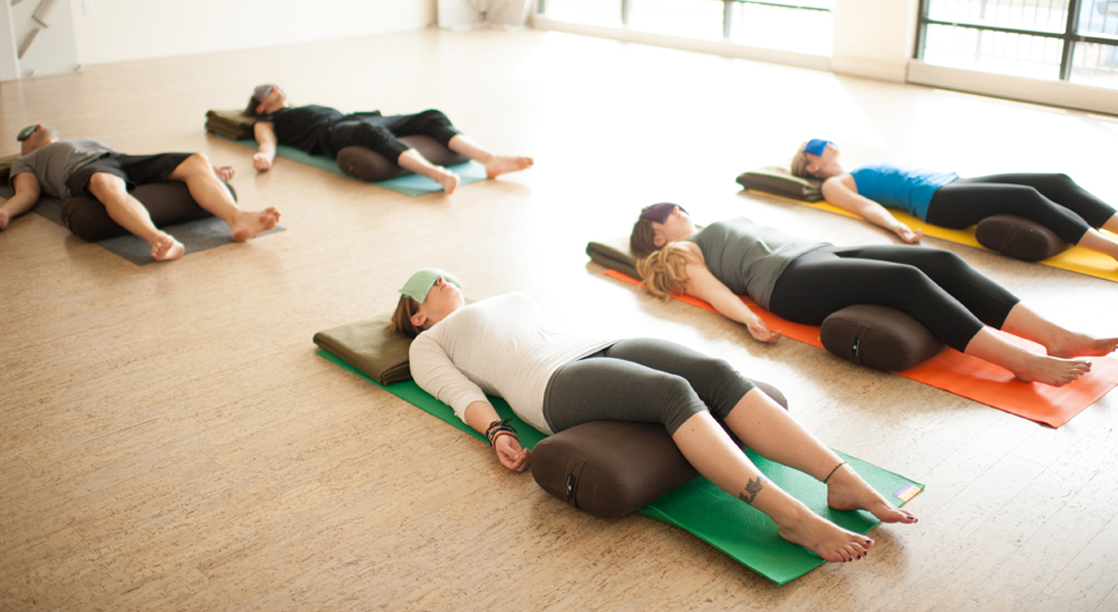
I’ve heard it many times, and said it many times: “Savasana is the most important pose. All the other poses we do in our asana practice lead to Savasana.”
For most students of yoga, this is good news. For most, Savasana is a welcome respite, a chance to unwind the body and simply be. Savasana provides a window into formlessness, into universal vastness and peace, our true Self. In Savasana, the boundaries between the body and the atmosphere around it disappear, while the mind stays awake and aware, settled back, observing thought bubbles and sensations from a place of spacious, non-grasping awareness.
When Savasana Is Challenging
Still, there are times when Savasana is challenging. Sometimes the body is restless, and then there’s the mind, obsessing about some joy or injustice in the recent or distant past, or jumping ahead into whatever we’ve got planned after Savasana. When there’s little physical sensation to occupy our attention, the mind slips easily into its default mode of planning, worrying and remembering. As the body lies still, the mind is free to travel wherever it likes. And travel it does, most often to the object of stress du jour. While knowing what is catching us, even in Savasana, is helpful information for us, spinning out in the agitated mind during Savasana doesn’t necessarily set us up for a peaceful day.
At other times, Savasana turns into a nap. And often a nap is the body’s most intelligent and appropriate response to an opportunity to stop for a few minutes. Most of our lives are full beyond a humane capacity with work, family and activities. Even our asana classes are often an expression of constant movement and non-stop input.
While physical activity can feel great after a day of static sitting at a computer, constant movement from one pose to the next can look an awful lot like running from work to errands to family responsibilities. Non-stop talk from a teacher mirrors our already overactive minds, and keeps them bouncing endlessly from one alignment point or pithy saying to the next during the active practice. No wonder we shut down in Savasana.
How Long Should You Rest in Savasana?
Why are some Savasana sessions spacious, peaceful and light while others are agitated, restless or fatigued? The reasons are likely multitudinous and individual. First among them, and perhaps most widely applicable is the factor of time. In most modern American asana classes, Savasana is given anywhere from three to possibly ten minutes (if you’re lucky). Especially after a fast-paced, sweaty vinyasa class, this is simply not enough time for the body to reach physiological relaxation, let alone move into spacious consciousness.
Judith Hanson Lasater, longtime yoga teacher, physical therapist and PhD in East-West Psychology, says that it takes a body an average of 15 minutes to reach physiological relaxation after a typical asana practice. Once the body has reached physiological relaxation, we may begin to experience pratyahara, the fifth limb of yoga, defined as withdrawal from the senses.
Pratyahara is the beginning of meditation, the state in which we are fully aware of what is arising in our sense stores, but we are no longer pulled out of our center by them. In pratyahara, we are free from our addiction to the senses. Once we have reached pratayahara in Savasana, we may—or may not—then move into states of deeper, more spacious awareness.
In my own practice, the perfect duration for Savasana depends on my preceding asana practice. On the days when my practice includes more active asanas such as standing poses and backbends (always with an appropriate cool-down time toward the end) it takes 20 to 25 minutes in Savasana for my body/mind to reach the expanded state that is Savasana. On the days when my practice is quieter, with restorative poses and forward bends, sometimes I will move into pratyahara after just a few minutes. Even when I shift into expansion relatively quickly, I never cut my Savasana short. Instead, I allow my body/mind to move ever more deeply into stillness.
The Settling of the Mind
My favorite translation of Sutra 1.2, the verse that defines yoga comes from Alistair Shearer: “Yoga is the settling of the mind into silence.”
All the limbs of yoga, including the physical practice, are meant to lead us to the deep silence that we all are. Let your daily practice change and evolve. Be mindful of and open to what you truly need. On days when your energy is low, replenish with restorative poses. On days when your energy is more plentiful, more active poses might be appropriate.
Then listen to what Savasana tells you about the quality of your practice. Could you never quite relax? Did you immediately zonk out? How does this coincide with your preceding asana practice? Savasana can lead us to the center of who we are, the state of yoga. Give Savasana the time it—and you—deserve.
